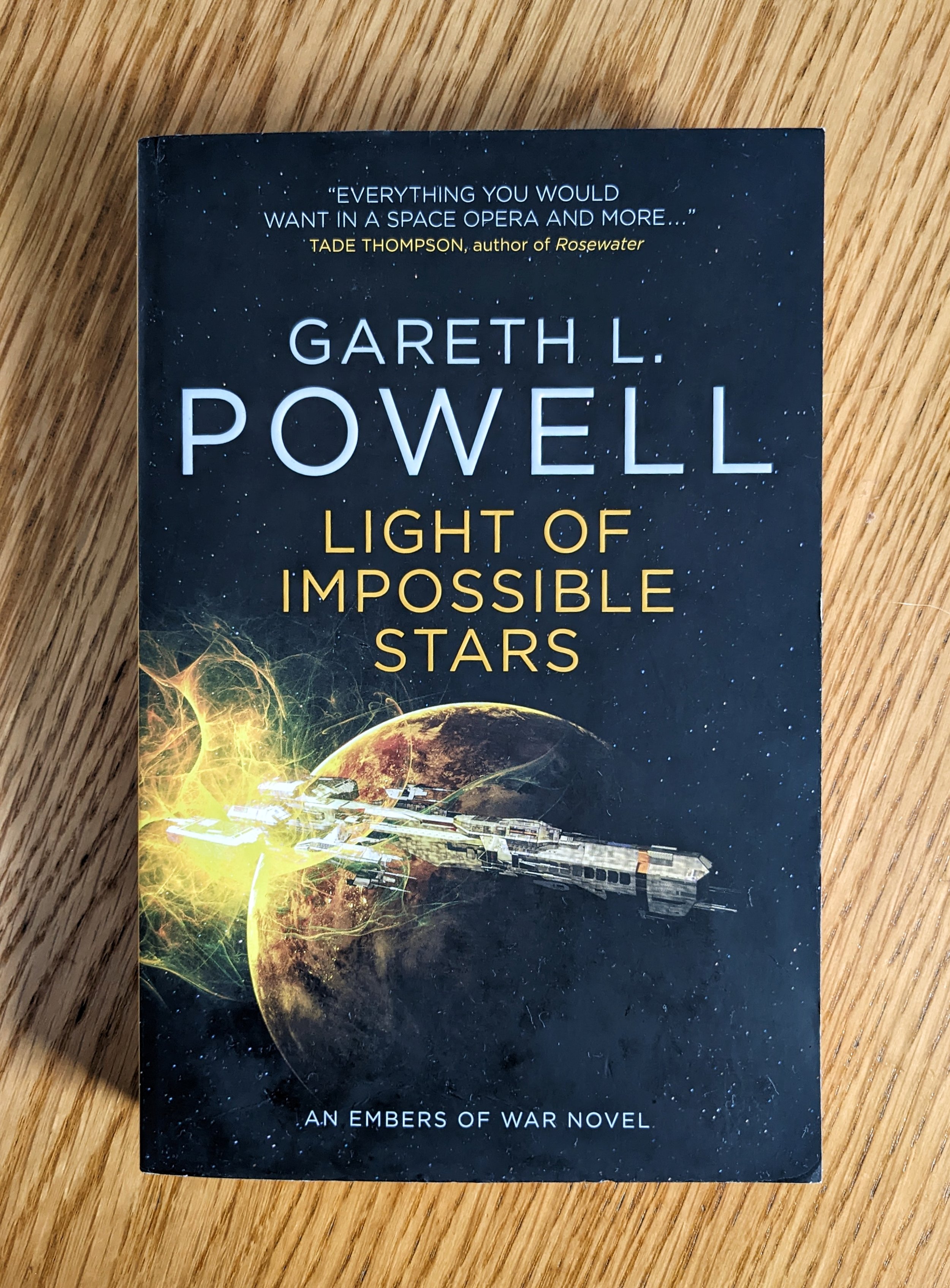Book Review: Light of Impossible Stars
The thrilling conclusion to Gareth L. Powell’s marvellous Embers of War trilogy.
It’s been a long time coming, but I’ve finally read Light of Impossible Stars. Last time - when I reviewed the second book in the series - I said I wouldn’t leave it too long before reading the last book, but it took more time to get to than I had anticipated. Having now finished the trilogy, I can say with confidence that it is an absolute masterwork. Carefully and meticulously crafted, there’s not a word or phrase used idly. Before I dive into the review proper, I wanted to talk briefly about the prose in a broad sense across the whole series. It took me a while to really notice Gareth’s prose, in fact I think I said in my review for Embers of War that the prose there was “evocative and functional”, but I think that does it a disservice. It is very functional, but I found it so smooth, so easy to read, that the words became almost invisible; I was in conversation with the characters themselves. It’s beautiful and immersive, and has a masterful use of vocabulary. I needed to clarify that, because I feel I gave the impression that it was merely there and serviceable, when actually it’s really great. Anyway, onto the review:
Blurb
Low on fuel and hunted by the Fleet of Knives, the sentient warship Trouble Dog follows a series of clues that lead her to the Intrusion--an area of space where reality itself becomes unstable. But with human civilisation crumbling, what difference can one battered old ship have against an invincible armada?
Meanwhile, Cordelia Pa and her step-brother Michael eke out their existence salvaging artefacts from an alien city. But when Cordelia is snatched from her home, she begins a journey that will help her understand the strange songs she hears in her head and the strange things that happen around her. What extraordinary affinity does she have for this abandoned alien technology, and how can it possibly help the Trouble Dog?
Review
Light of Impossible Stars continues on from where we left the Trouble Dog and her crew at the end of Fleet of Knives: in the midst of cataclysm. And just like in the previous two books, we also start off with a completely separate viewpoint for a new set of characters the crew of the Trouble Dog are destined to meet at some point later on as the storylines converge. It’s a winning formula. And it was interesting to me to notice this as a stylistic thing. Some authors will keep all the characters together from start to finish and keep to a singular POV; other authors like to start off with all the characters together and then have them go off in different directions further along in the story, shifting POV as necessary (I do this in From the Grave of the Gods); and still others - like Gareth has done in the Embers of War trilogy - will start with separated groups and have them meet for the first time later on. It really depends what serves the given story best, and here, it’s served very well.
Plot and worldbuilding-wise, we not only get satisfying answers to all the mysteries set up in the previous two books, but it also goes off in ways I didn’t expect. Light of Impossible Stars was a thrilling ride from start to finish with plenty to stoke the imagination. Gareth doesn’t just let the worldbuilding settle from the previous two books either. I was very impressed with the inclusion of technologies I hadn’t seen before - particularly the Plates. There’s been a lot of thinking around different types of worlds throughout SF over the last century; we’ve had O’Neill cylinders, Ringworlds, Dyson Spheres, and a whole host of other great space habitats. Gareth’s Plates are a refreshing and interesting take on that kind of concept.
Going off on a bit of a tangent here, I’m envious of the way in which Gareth has unashamedly made one of the main antagonistic forces work. Many years ago, when I was first thinking through concepts that would become the Augment Saga, I had an idea for a series-ending antagonist that was similar to the creatures in Fleet of Knives and Light of Impossible Stars. And I thoroughly dismissed it as something that I could not make work at all. I felt like it would be seen as too ridiculous, like a “jumping the shark” moment. Indeed, it no longer fits the direction I eventually chose for my series, but I was completely wrong about the concept not working, because it absolutely works here, one hundred percent. I loved it. Bravo, Gareth!
This series has given me some of my favourite ever characters in fiction: Nod and Trouble Dog in particular. And the pairing of Trouble Dog with Sal Konstanz is brilliant, I love their dynamic throughout the series. Nod though… Man, Nod. What a great character! It starts off as a bit weird in Embers of War but the little hand-faced engineer really grows on you. The characters in the book are exceptionally well-written and you end up caring for all of them. I enjoyed Cordelia’s segments, and her version of a misfit crew provides a great contrast to the misfit crew of the Trouble Dog. On the negative side, there were a couple of moments that fell a bit flat for me, mainly towards the end involving Ona Sudak, but it didn’t detract from my enjoyment of the book as a whole.
Overall, I would highly recommend this trilogy, it really does represent some of the best of modern SF. Whether you’re just getting into SF or looking for more recent additions to the genre, you absolutely cannot go wrong with this series.

